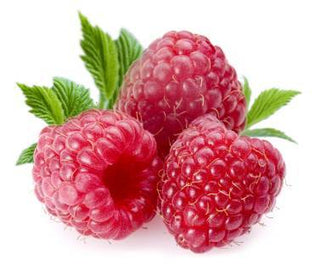(Rubus idaeus)
Raspberries are a member of the rose family and are considered a bramble fruit. Sweet with slightly tart overtones, raspberries are known as “aggregate fruits”. Each delicate fruit is made up of around 100 drupelets (juicy pulps surrounding a single center seed) arranged around a hollow middle cavity.
While the most common type of raspberry is red-pink, raspberries come in a broad range of colors including black, purple, orange, yellow and white. Golden or yellow raspberries are the result of a recessive gene that impedes the production of anthocyanin – the phytonutrient that gives raspberries their deep pink coloring. Despite their unfamiliar appearance, these lighter colored raspberries still have the distinctive flavor of their respected species.
Raspberries are native to Europe but are now cultivated in several temperate climates around the globe. Although several subspecies of raspberries exist, most are derived from hybrids between R. idaeus (European raspberry) and R. strigosus (American Raspberry). Today, primary raspberry producers include Poland, United States, Germany and Chile.
Nutrition
Not only are raspberries delicious, they are nutritional powerhouses. One cup of raspberries has just 64 calories. While a cup contains five grams of sugar, these berries deliver a surprising 8 grams of fiber.
Raspberries are an excellent source of vitamin C, containing 32.2 mg or 54% of the suggested daily intake. These delicate berries are also a good source of vitamin K, providing 12% of daily values.
On the mineral side, raspberries are an excellent source of manganese, providing 41% of the suggested daily intake. Raspberries also contain some magnesium, copper, iron and potassium.
Health Benefits
The antioxidant levels in raspberries are 50% higher than that of strawberries, three times higher than kiwifruit, and 10 times higher than tomatoes.
The biggest contribution to raspberry’s antioxidant activity comes from ellagic acid. Ellagic acid belongs to the family of phytonutrients called phenolics and is found in raspberries, acai berries and pomegranate. These plant chemicals may help prevent cancer by inhibiting the growth of cancer cells. It is estimated that ellagic acid provides up to 65% of the total antioxidant activity in a serving of raspberries. Vitamin C contributes another 20% and the remaining consists of anthocyanins (in particular pelagonidin glycosides and cyanidin).
Anthocyanins, the pigments responsible for raspberries deep red color, also contain some antioxidant and antimicrobial properties. One of the key health benefits of anthocyanins is their ability to prevent overgrowth of certain types of bacteria and fungi in the body.
The flavonoid content of raspberries is also well-documented. Here the key substances are quercetin, kaempferol, and the cyanidin-based molecules called cyanidin-3-glucosylrutinoside and cyanidin-3-rutinoside.
Selection and Storage
In season June through October, raspberries are extremely perishable and should be purchased no more than a day or two before you intend to use them.
When making your selection, look for bright berries, firm and plump with the green cap attached. Avoid berries that are dull in color or appear soggy. Make sure to avoid a container where berries are packed too tightly - crushed or damaged berries spoil quickly. Do not wash raspberries until you are ready to enjoy them.
Be sure to store raspberries in the refrigerator. You can leave your raspberries in their original container or lay them flat on a paper towel covered with plastic wrap. Raspberries will remain fresh in the refrigerator for up to two days.
Raspberries freeze wonderfully. Gently rinse the berries and pat softly with a paper towel. Lay the berries flat on a baking sheet and place it in the freezer. Once they have frozen, transfer them to a large plastic bag. Stored in the freezer they will keep for up to a year.
Recipes
Like most fruit, raspberries are best enjoyed raw. Nothing tastes better than a healthy breakfast of Greek yogurt topped with fresh raspberries.
For those who like their raspberries a little on the savory side, try Raspberry-Balsamic Glazed Chicken. If you’re trying to keep cool, try light, refreshing, Raspberry Lemonade.
So what if you accidentally leave your fragile raspberries in the fridge for a little bit too long? No problem! Make a natural face mask that will help fade age spots and discoloration. Combine 2 cups of fresh raspberries and 1 cup of plain yogurt then blend until smooth. Apply the mixture to your face and let it sit for 15 minutes. Rinse with water.
Fun Facts
Purple-fruited raspberries have been found in the wild in a few places where the American red and the black raspberries both grow naturally.

